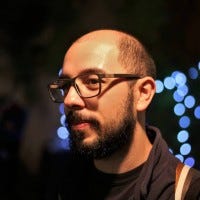
Featured Blog | This community-written post highlights the best of what the game industry has to offer. Read more like it on the Game Developer Blogs.
A game about People: Friendship, Love and Gender
[...] There is a very important learning that I took from this first version, something that I carry with me forever. At this time the game had heterosexual and homosexuals, men and women, besides the division of blacks and whites.

People was a game that emerged within a feminist group into the university. I had gone to a lecture by Leticia Rodrigues on Gender in Games (or G.G.) and, from it, a discussion group about the theme was born. The group meetings were instructive and theoretical and we talked a lot about the importance of representativeness in games. The group showed the differences between genders, the plurality of sexualities and the problems with prejudice within the community of players.
Over time, the theoretical group decided that it would be interesting to create a game that spoke of these theories. This is how we started to talk about what we should insert into the game, how to deal with it in a way that was not offensive or very generalist and, as always, fun, without losing the essence of being a game.

The process was filled with intense research and prototyping, the idea was to make an analog game, since at that time there were not many programmers in the group. In the beginning the game had a board and approached the media representation of gender and there was a battle for representativeness. This generated several other problems and it seemed that at the end of the game there would be genders that losing. We changed the purpose, because the game had to have a positive message.
I began to study card games to find mechanics that might be interesting to explore. It was a good time to play several games in the university library and enjoy these matches to talk about the issues we wanted to address in the game. Many people went through the project giving ideas, sharing suggestions and theories. Whenever I came up with any possible idea to prototype, I would go to the group to see everyone's opinion. That's how I got the first version of the game.
There is a very important learning that I took from this first version, something that I carry with me forever. At this time the game had heterosexual and homosexuals, men and women, besides the division of blacks and whites. The game idea was to bring representation, and we believe that we could do this in every way, for every fight. The game worked well with these chart statuses: color, sex, gender. Since Color did not make any difference in the rules, the idea was that, no matter how much of a difference, as a rule, it did not matter. We are all the same.
We were happy with this prototype, but we were just talking to each other, we needed to take the game out and test, see if it worked or it was offensive. So, I put the prototype in the bag and go out to play with people. One of the groups I played there was a black friend, he played the game very interested, at one point he asked: What is the difference between the black and white cards, and I answered promptly "None!" believing that this would be my victorious argument against racism, and he completes "So why did you make them different?".
He explained that if the black and white cards are no different, then why were there different cards, separated by an icon, as if they were not the same? The fact that there was color division in the game reinforced the existence of division in real life. It blew my mind. I had never really thought about it. I needed to correct that, and the correction we got was simple, it was enough to make the art of the cards represent the greatest number of people. This opened the game to something more beautiful and full of possibilities. By the art of cards we could put colors, styles, people with disabilities, everything we could represent! We came to a more beautiful, interesting and much better selection than my initial foolish thought.
The project moved on, I started working on balancing the game and on how many cards there should be to pair and what the points system would look like. The idea was anyone who could do the most diverse society would make more points, and I needed to create a situation that generated a moment of decision in the player, so it was not just down cards, but also have some strategy involved. I felt like Game Designer the game was still not fun and interesting, as a gender speech it seemed to work but people would play and say "Got it" and voila, it was not fun. How to solve this without being unfair to the genders? It was a bit too delicate, I took the group to discuss and, as usual, our conversations left the game to talk about everyday situations, games and social struggles. This time on the subject came the discussion about trans people, and that lit a light on me, that was what was missing, a new alternative.
So I went back to the drawing board to put this new layer of men and women in our chart society on my balance table. The idea fit like a glove! The game was dynamic, allowed a new decision making in the game. Along the trans started working, we put bisexual cards, they act as a wildcard to speed up the dynamics of the game, but also brought another point of the gender debate for the game. The most interesting thing was that the idea that this new type of card had its relevance in the game, but in practical terms, the fact that it was trans did not make any difference! Just stop thinking about trans, and think about Man and Woman, and you are free of your prejudices. But I had already learned the lesson, I had to test this idea with a focus group, and that's what we did.

There is new learning here, and this time it was in the UI part. We did an art using the popular symbols of hetero, homo and trans sexual, the problem is that, by the UN, there are many recognized genders and each of them has its own symbols and particular situations. We opted for one that seemed to be the most interesting and we put it in the new prototype and went to a discussion group about transsexuality. Success! They liked the game and they loved the representativeness. The game was fun but ... We came to discover some things, no one there liked to be treated as a third gender, after all, all there are men and women and that's it. Moreover, in order to end all the balancing I had done, we came to discover that among them there were some who were heterosexual and other homosexuals. There really was no difference at all...
It is good to get to the bottom of this point because even today people get confused by it. When a person makes the transition between genders, he/she does not keep anything from before. She/He is, what he/she is. Of course there are situations that are not like this so, in the end, genders are very private and personal situations. But in terms of representativeness people are what they feel to be, and the game was presenting an external, and not inclusive, view.
It was a sense of frustration within a dilemma. The game was fun, but it did not respect all the gender discussion we wanted. In fact I did not know what to do to improve this. I said that I would give the project time to do other things, because I really was without any ideas.
It was after a while, playing the game and talking about gender that we came to a new situation. We think the game is to precious to stop development, we needed to finish it. It was also reaching the deadline for the SBGames, a game event in which we thought it would be amazing to write the game. At that time we talked more about the art of the game, we wanted to make a game without text, to be easy for it to spread around the world, and these things of the symbols were very complex to do, since we should not create a third symbol for trans people. This was complicated. We concluded that the game was about people, so calling it PEOPLE was something natural. Leticia Rodrigues took my ugly cards from the prototype and made them beautiful. The game was getting cool, but how to solve the representation problem, after all, that is the goal of the game, to make a fun and representative game.

It was during one of those conversations while we were playing the game that someone said, "Curious, right? Being trans makes no difference at all". We all knew that, but I think it was said in a moment that made me realize that this was it. It would be possible to simply treat the trans cards as heterosexual and homosexual, and that's it. It would be a step back, but it would not be enough to do different arts as in the discussion of racism, because it would not be possible to represent trans people in the images, after all, it made no difference in art, as it does not in real life, it would have to be indicated in some way. We just needed to create an icon that made sense. So I went back to Leticia Rodrigues with the solution who became from chemistry. Heterogeneous solutions are solutions that we can see several colors in the formula, and homogenies that we cannot see the mixture. We made icons in black and white, where those who were only one color were homo and those who had two colors were heteros, and what indicated the trans sexuality was only the position of the symbols. For us it was an amazing eureca! I returned to balance, all working in a basic Zero-Sum and the arts were beautiful! We had a functional prototype! But we realized that the symbols could be a bit confusing, and I did a query table for points and iconography, that went against the rules of not using texts, but for the prototype it seemed to work.

The game also had the hobby, the cards could enjoy video games, movies or books, this allowed creating group of friends or strongest couples and also using the bi sexual card the player allowed the opening of polyamorous relationships, difficult to do but that allowed to make many points. That is, combining hobbyes, sexuality and a different group of people, it was possible to create groups that love each other, but also couples or many friends, creating a society without prejudices.
People started playing and identified with the cards, even without the character arts, they saw a homosexual trans girl who liked video games and automatically felt connected with the cards. Some people tried independently of the points, set up their own groups of friends on the table, mixing people, and telling who should relate to those in their own worlds. No doubt the representativeness was more than inserted in the game. People played, argued and had fun. The game was working.
But of course it was not perfect, even within the feminist, trans, homosexual groups that had always complained that some genders were left out or seemed to be being represented in a simplified way. The critics, however, were much smaller and even in them, there was praise and recognition of the importance of the game. Only the bi sexual card still generates some controversy. So much so that we change to call it "Curious", someone who has bigger interests than just a simple relationship. The card became yet another joker that allowed the polyamorous relationship. I thought I was forcing game mechanics back on the gender discussion, but again, we found people identifying with the cards. We knew from the beginning that the game would not be perfect and at the point we arrived, it would be almost impossible to please everyone.
(This is the video presentation of the game for SBGames)
So, we sent the game to SBGames, we became finalists, but when we presented the game in the event, we received praise for the idea but it was not yet an end product, for the time we had we could only take the prototype, and there was no way to receive the prize. They did not disqualify us, at least we were among the finalists.
There were still problems with symbols, they are not perfect, and with people's mental confusion about how genders work, it was difficult to find the answer to their doubts about how symbols work. As someone who seeks change in the world I wanted to leave the symbols as they are. People confused about genders that find the answer within them and do not blame the game for their own prejudices. However, as Game Designer, it was imperative to solve this. Even today I have no answer. After the SBGames the frenzy to finish the game ended. I felt like I had done my job and now we needed a bigger artwork to finalize the project, creating the arts of the characters as we dreamed.
Our plan was to summon everyone to help, different arts of different people stamped the cards, all done collaboratively and distributed free on the internet. We would make the rules in as many languages as we could and spread this message of love and friendship around the world. But life is a box of surprises. Our group just went on vacation and it took forever to come back. I needed to focus on my career, being Game Designer in Brazil is not that easy, and I needed to do more games for my portfolio, besides studying more to improve myself. Over time, I was hired in another city, in the far north of the country, and I left the project behind, in the hands of the group and whoever wanted to take over. I do not feel like the owner of this project, and today, the name has changed, other people are working on it.
My distance from the project ended up making it even more beautiful. Another game designer took over the project together with a talented artist, they solved all the problems that the game had. My ideas for the game and how to do the cards were simply discarded and this gave way to a new game. Still with the same essence and mechanics, but now with many more genders, much more love and still made with the strength of friendship.
Now the game is called Gente, a Portuguese name. There is no longer the character arts, all solved in a simpler way and within reach of what we can do without losing functionality and beauty. Feeling that the game was still alive, even in my absence, for me, shows how important and interesting the game is. And it has got even better, shows that the more people, interested in doing something with desire, can create something unique.

Now, this new game will again compete for SBGames! And this is the new video presentation of the game for the event.
If you wanted to play, feel free! It is available on the internet. Free as the world should be.
https://gentejogodecartas.wordpress.com/
Read more about:
Featured BlogsAbout the Author(s)
You May Also Like












